sensor PEUGEOT 308 2016 User Guide
[x] Cancel search | Manufacturer: PEUGEOT, Model Year: 2016, Model line: 308, Model: Peugeot 308 2016Pages: 344, PDF Size: 12.23 MB
Page 85 of 344
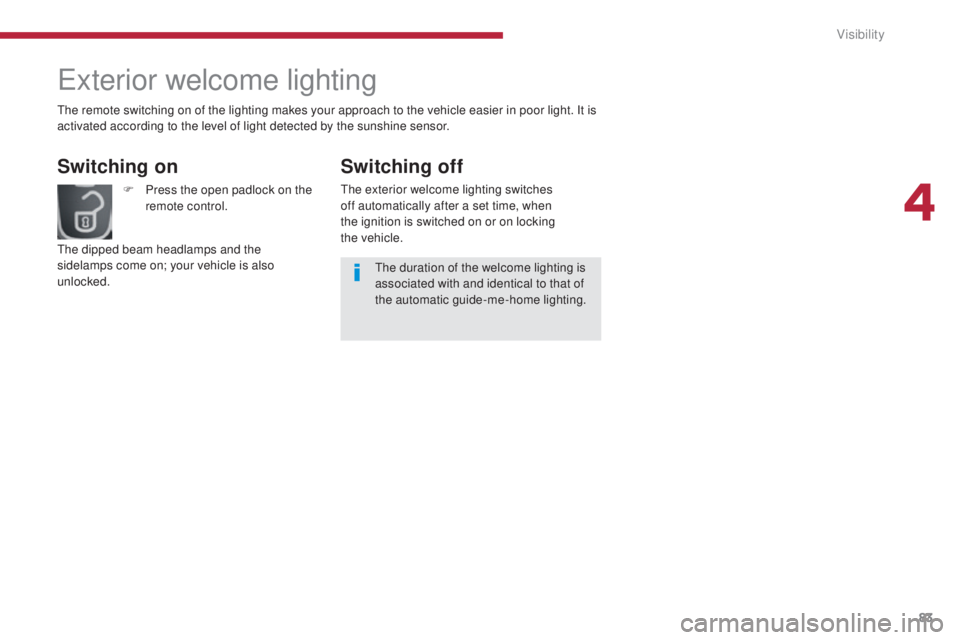
83
3008_en_Chap04_visibilite_ed01-2015
Exterior welcome lighting
Switching on
F Press the open padlock on the remote control.
The dipped beam headlamps and the
sidelamps come on; your vehicle is also
unlocked. The duration of the welcome lighting is
associated with and identical to that of
the automatic guide-me-home lighting.
Switching off
The exterior welcome lighting switches
off automatically after a set time, when
the ignition is switched on or on locking
the
vehicle.
The remote switching on of the lighting makes your approach to the vehicle easier in poor light. It is
activated according to the level of light detected by the sunshine sensor.
4
Visibility
Page 91 of 344
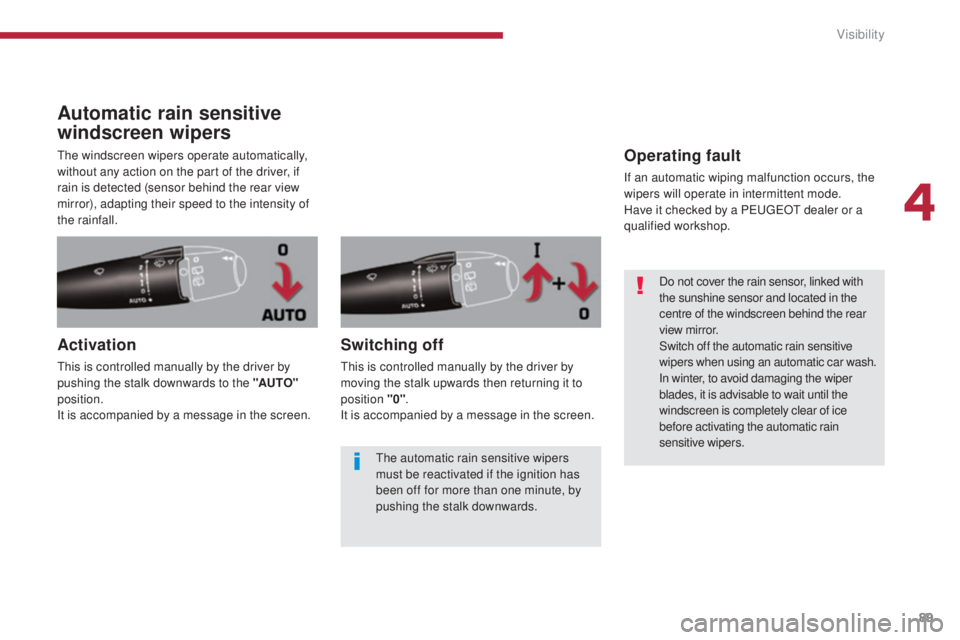
89
3008_en_Chap04_visibilite_ed01-2015
Automatic rain sensitive
windscreen wipers
The windscreen wipers operate automatically,
without any action on the part of the driver, if
rain is detected (sensor behind the rear view
mirror), adapting their speed to the intensity of
the rainfall.
Activation
This is controlled manually by the driver by
pushing the stalk downwards to the "AUTO"
position.
It is accompanied by a message in the screen.
Switching off
This is controlled manually by the driver by
moving the stalk upwards then returning it to
position "0" .
It is accompanied by a message in the screen.
Operating fault
If an automatic wiping malfunction occurs, the
wipers will operate in intermittent mode.
Have it checked by a PEUGEOT dealer or a
qualified workshop.
Do not cover the rain sensor, linked with
the sunshine sensor and located in the
centre of the windscreen behind the rear
view mirror.
Switch off the automatic rain sensitive
wipers when using an automatic car wash.
In winter, to avoid damaging the wiper
blades, it is advisable to wait until the
windscreen is completely clear of ice
before activating the automatic rain
sensitive wipers.
The automatic rain sensitive wipers
must be reactivated if the ignition has
been off for more than one minute, by
pushing the stalk downwards.
4
Visibility
Page 153 of 344
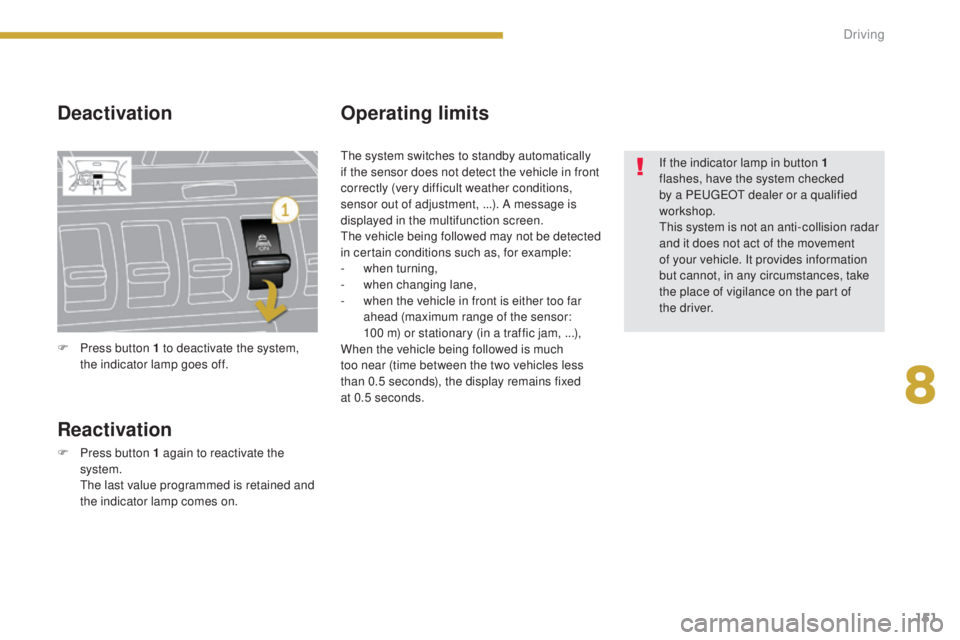
151
3008_en_Chap08_conduite_ed01-2015
Deactivation
Reactivation
F Press button 1 again to reactivate the system.
T
he last value programmed is retained and
the indicator lamp comes on.
Operating limits
If the indicator lamp in button 1
flashes, have the system checked
by a PEUGEOT dealer or a qualified
workshop.
This system is not an anti-collision radar
and it does not act of the movement
of your vehicle. It provides information
but cannot, in any circumstances, take
the place of vigilance on the part of
the
driver.
F
P
ress button 1 to deactivate the system,
the indicator lamp goes off. The system switches to standby automatically
if the sensor does not detect the vehicle in front
correctly (very difficult weather conditions,
sensor out of adjustment, ...). A message is
displayed in the multifunction screen.
The vehicle being followed may not be detected
in certain conditions such as, for example:
-
w
hen turning,
-
w
hen changing lane,
-
w
hen the vehicle in front is either too far
ahead (maximum range of the sensor:
100 m) or stationary (in a traffic jam, ...),
When the vehicle being followed is much
too near (time between the two vehicles less
than
0.5 seconds), the display remains fixed
at
0.5 seconds.
8
Driving
Page 174 of 344
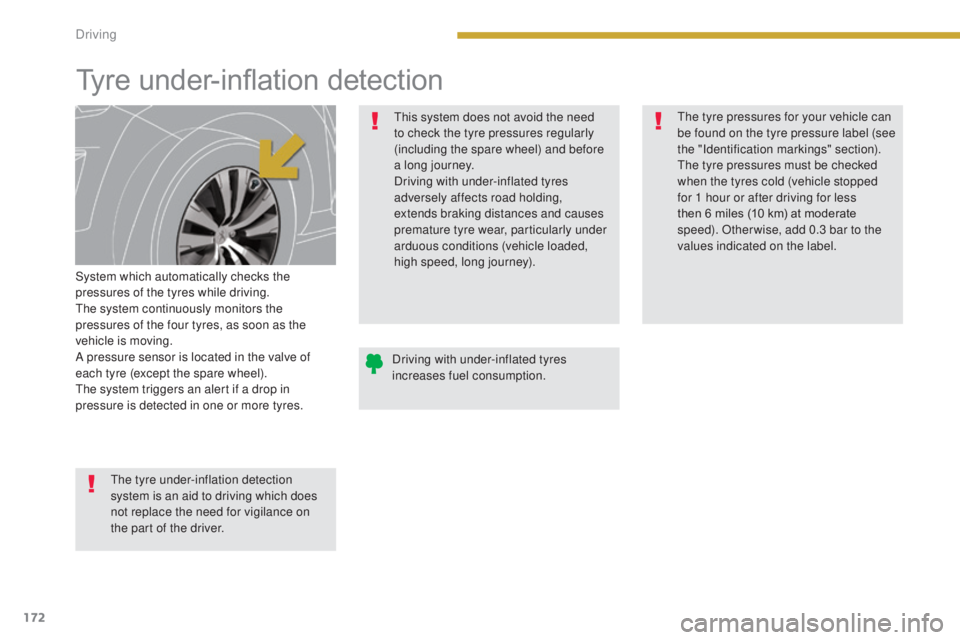
172
3008_en_Chap08_conduite_ed01-2015
Tyre under-inflation detection
System which automatically checks the
pressures of the tyres while driving.
The system continuously monitors the
pressures of the four tyres, as soon as the
vehicle is moving.
A pressure sensor is located in the valve of
each tyre (except the spare wheel).
The system triggers an alert if a drop in
pressure is detected in one or more tyres.This system does not avoid the need
to check the tyre pressures regularly
(including the spare wheel) and before
a long journey.
Driving with under-inflated tyres
adversely affects road holding,
extends braking distances and causes
premature tyre wear, particularly under
arduous conditions (vehicle loaded,
high speed, long journey).
The tyre pressures for your vehicle can
be found on the tyre pressure label (see
the "Identification markings" section).
The tyre pressures must be checked
when the tyres cold (vehicle stopped
for 1 hour or after driving for less
then
6 miles (10 km) at moderate
speed). Other wise, add 0.3 bar to the
values indicated on the label.
Driving with under-inflated tyres
increases fuel consumption.
The tyre under-inflation detection
system is an aid to driving which does
not replace the need for vigilance on
the part of the driver.
Driving
Page 175 of 344
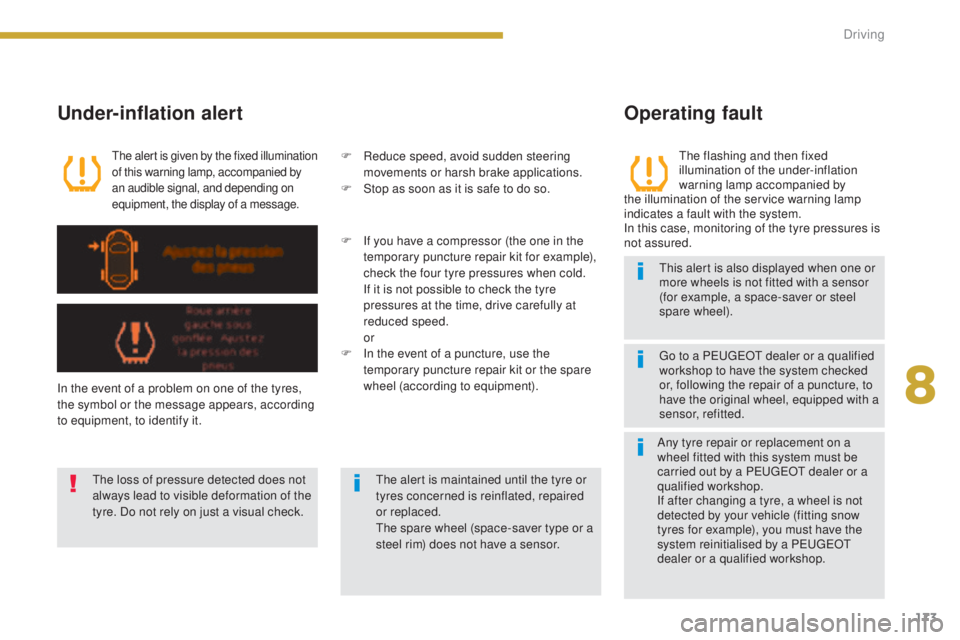
173
3008_en_Chap08_conduite_ed01-2015
The flashing and then fixed
illumination of the under-inflation
warning lamp accompanied by
the illumination of the service warning lamp
indicates a fault with the system.
In this case, monitoring of the tyre pressures is
not assured.
This alert is also displayed when one or
more wheels is not fitted with a sensor
(for example, a space-saver or steel
spare wheel).
Under-inflation alert
The alert is given by the fixed illumination
of this warning lamp, accompanied by
an audible signal, and depending on
equipment, the display of a message.
In the event of a problem on one of the tyres,
the symbol or the message appears, according
to equipment, to identify it. F
R
educe speed, avoid sudden steering
movements or harsh brake applications.
F
S
top as soon as it is safe to do so.
The loss of pressure detected does not
always lead to visible deformation of the
tyre. Do not rely on just a visual check. The alert is maintained until the tyre or
tyres concerned is reinflated, repaired
or replaced.
The spare wheel (space-saver type or a
steel rim) does not have a sensor.
Operating fault
Go to a PEUGEOT dealer or a qualified
workshop
to have the system checked
or, following the repair of a puncture, to
have the original wheel, equipped with a
sensor, refitted.
F
I
f you have a compressor (the one in the
temporary puncture repair kit for example),
check the four tyre pressures when cold.
I
f it is not possible to check the tyre
pressures at the time, drive carefully at
reduced speed.
or
F
I
n the event of a puncture, use the
temporary puncture repair kit or the spare
wheel (according to equipment).
Any tyre repair or replacement on a
wheel fitted with this system must be
carried out by a PEUGEOT dealer or a
qualified workshop.
If after changing a tyre, a wheel is not
detected by your vehicle (fitting snow
tyres for example), you must have the
system reinitialised by a PEUGEOT
dealer or a qualified workshop.
8
Driving
Page 176 of 344
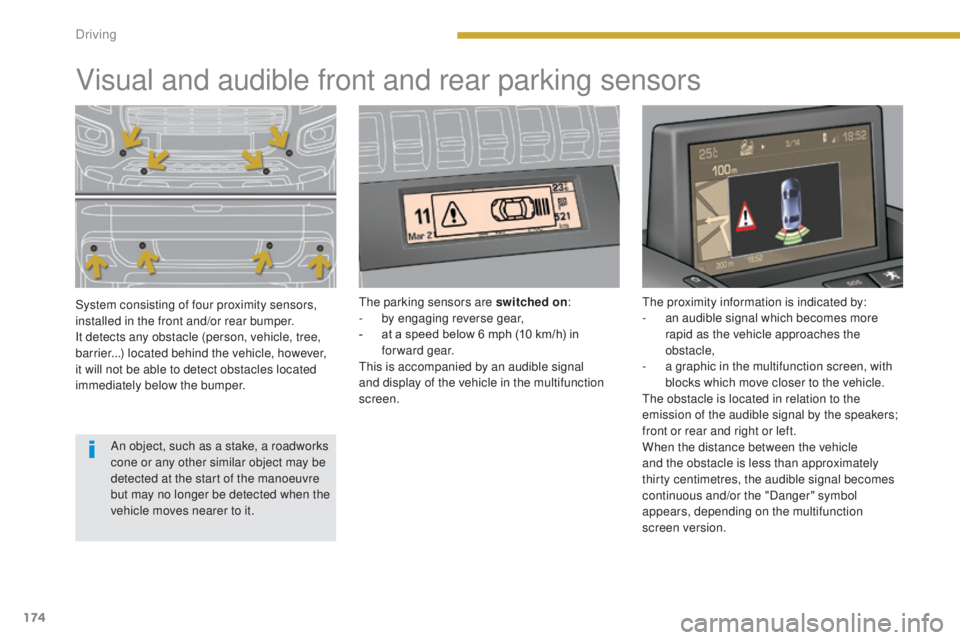
174
3008_en_Chap08_conduite_ed01-2015
Visual and audible front and rear parking sensors
System consisting of four proximity sensors,
installed in the front and/or rear bumper.
It detects any obstacle (person, vehicle, tree,
barrier...) located behind the vehicle, however,
it will not be able to detect obstacles located
immediately below the bumper.The parking sensors are switched on
:
- b y engaging reverse gear,
-
a
t a speed below 6 mph (10 km/h) in
forward gear.
This is accompanied by an audible signal
and display of the vehicle in the multifunction
screen. The proximity information is indicated by:
-
a n audible signal which becomes more
rapid as the vehicle approaches the
obstacle,
-
a g
raphic in the multifunction screen, with
blocks which move closer to the vehicle.
The obstacle is located in relation to the
emission of the audible signal by the speakers;
front or rear and right or left.
When the distance between the vehicle
and the obstacle is less than approximately
thirty centimetres, the audible signal becomes
continuous and/or the "Danger" symbol
appears, depending on the multifunction
screen version.
An object, such as a stake, a roadworks
cone or any other similar object may be
detected at the start of the manoeuvre
but may no longer be detected when the
vehicle moves nearer to it.
Driving
Page 177 of 344
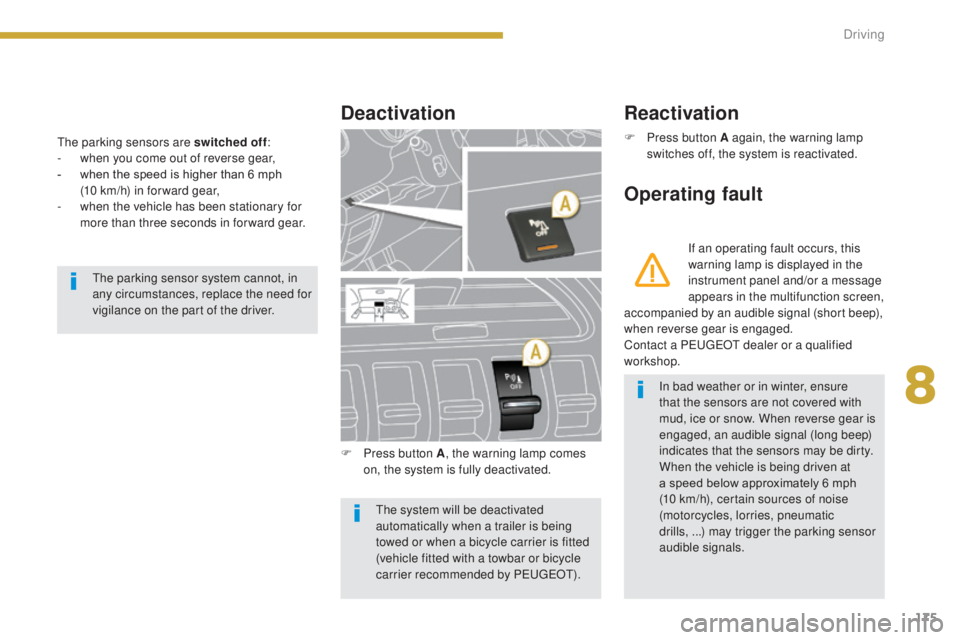
175
3008_en_Chap08_conduite_ed01-2015
The parking sensors are switched off:
- w hen you come out of reverse gear,
-
w
hen the speed is higher than 6 mph
(10 km/h) in for ward gear,
-
w
hen the vehicle has been stationary for
more than three seconds in forward gear.
Deactivation
Operating fault
F Press button A again, the warning lamp switches off, the system is reactivated.
F
P
ress button A , the warning lamp comes
on, the system is fully deactivated. If an operating fault occurs, this
warning lamp is displayed in the
instrument panel and/or a message
appears in the multifunction screen,
accompanied by an audible signal (short beep),
when reverse gear is engaged.
Contact a PEUGEOT dealer or a qualified
workshop.
The parking sensor system cannot, in
any circumstances, replace the need for
vigilance on the part of the driver.
The system will be deactivated
automatically when a trailer is being
towed or when a bicycle carrier is fitted
(vehicle fitted with a towbar or bicycle
carrier recommended by PEUGEOT).In bad weather or in winter, ensure
that the sensors are not covered with
mud, ice or snow. When reverse gear is
engaged, an audible signal (long beep)
indicates that the sensors may be dirty.
When the vehicle is being driven at
a speed below approximately 6 mph
(10 km/h), certain sources of noise
(motorcycles, lorries, pneumatic
drills, ...) may trigger the parking sensor
audible signals.
Reactivation
8
Driving
Page 179 of 344
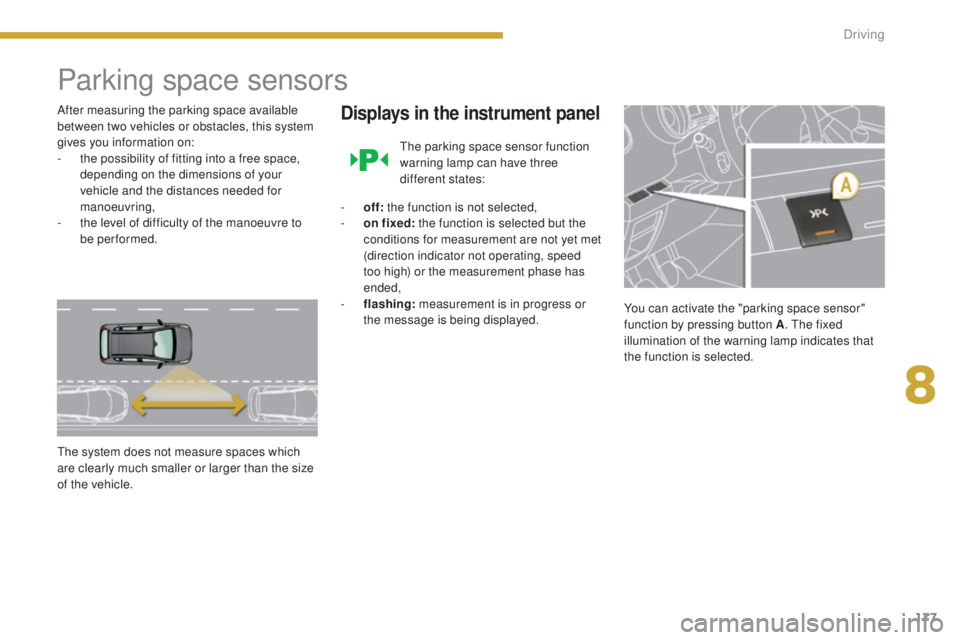
177
3008_en_Chap08_conduite_ed01-2015
Parking space sensors
After measuring the parking space available
between two vehicles or obstacles, this system
gives you information on:
-
t
he possibility of fitting into a free space,
depending on the dimensions of your
vehicle and the distances needed for
manoeuvring,
-
t
he level of difficulty of the manoeuvre to
be performed.
The system does not measure spaces which
are clearly much smaller or larger than the size
of the vehicle.Displays in the instrument panel
The parking space sensor function
warning lamp can have three
different states:
-
o
ff: the function is not selected,
-
o
n fixed: the function is selected but the
conditions for measurement are not yet met
(direction indicator not operating, speed
too high) or the measurement phase has
ended,
-
f
lashing: measurement is in progress or
the message is being displayed. You can activate the "parking space sensor"
function by pressing button A
. The fixed
illumination of the warning lamp indicates that
the function is selected.
8
Driving
Page 180 of 344
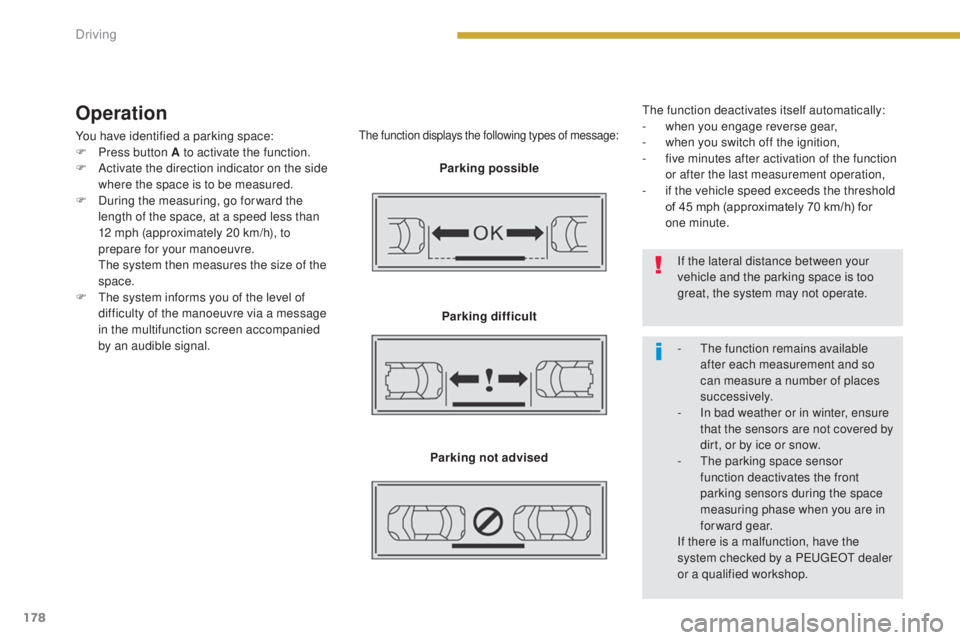
178
3008_en_Chap08_conduite_ed01-2015
Operation
You have identified a parking space:
F P ress button A to activate the function.
F
A
ctivate the direction indicator on the side
where the space is to be measured.
F
D
uring the measuring, go for ward the
length of the space, at a speed less than
12 mph (approximately 20 km/h), to
prepare for your manoeuvre.
T
he system then measures the size of the
space.
F
T
he system informs you of the level of
difficulty of the manoeuvre via a message
in the multifunction screen accompanied
by an audible signal.The function displays the following types of message:
Parking possible
Parking difficult
Parking not advised The function deactivates itself automatically:
-
w
hen you engage reverse gear,
-
w
hen you switch off the ignition,
- f ive minutes after activation of the function
or after the last measurement operation,
-
i
f the vehicle speed exceeds the threshold
of 45 mph (approximately 70 km/h) for
one minute.
If the lateral distance between your
vehicle and the parking space is too
great, the system may not operate.
-
T
he function remains available
after each measurement and so
can measure a number of places
su c c e s s i ve l y.
-
I
n bad weather or in winter, ensure
that the sensors are not covered by
dirt, or by ice or snow.
-
T
he parking space sensor
function deactivates the front
parking sensors during the space
measuring phase when you are in
forward gear.
If there is a malfunction, have the
system checked by a PEUGEOT dealer
or a qualified workshop.
Driving
Page 212 of 344
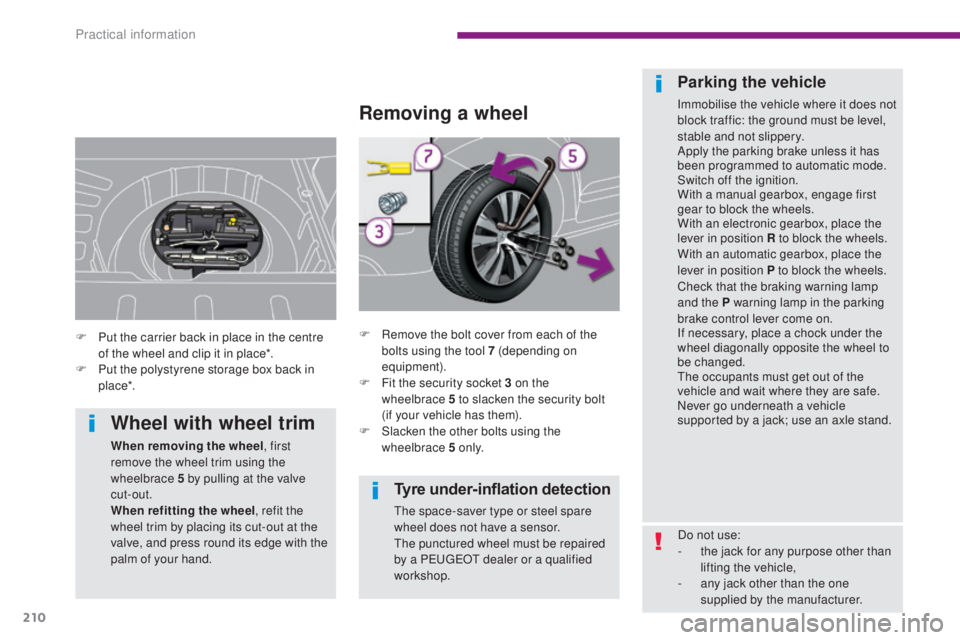
210
3008_en_Chap10_infos-pratiques_ed01-2015
Tyre under-inflation detection
The space-saver type or steel spare
wheel does not have a sensor.
The punctured wheel must be repaired
by a PEUGEOT dealer or a qualified
workshop.
Removing a wheel
F Remove the bolt cover from each of the bolts using the tool 7 (depending on
equipment).
F
F
it the security socket 3 on the
wheelbrace
5 to slacken the security bolt
(if
your vehicle has them).
F
S
lacken the other bolts using the
wheelbrace 5 o n l y.
Parking the vehicle
Immobilise the vehicle where it does not
block traffic: the ground must be level,
stable and not slippery.
Apply the parking brake unless it has
been programmed to automatic mode.
Switch off the ignition.
With a manual gearbox, engage first
gear to block the wheels.
With an electronic gearbox, place the
lever in position R to block the wheels.
With an automatic gearbox, place the
lever in position P to block the wheels.
Check that the braking warning lamp
and the P warning lamp in the parking
brake control lever come on.
If necessary, place a chock under the
wheel diagonally opposite the wheel to
be changed.
The occupants must get out of the
vehicle and wait where they are safe.
Never go underneath a vehicle
supported by a jack; use an axle stand.
F
P
ut the carrier back in place in the centre
of the wheel and clip it in place*.
F
P
ut the polystyrene storage box back in
p lac e*.
Wheel with wheel trim
When removing the wheel , first
remove the wheel trim using the
wheelbrace 5 by pulling at the valve
cut-out.
When refitting the wheel , refit the
wheel trim by placing its cut-out at the
valve, and press round its edge with the
palm of your hand. Do not use:
-
t
he jack for any purpose other than
lifting the vehicle,
-
a
ny jack other than the one
supplied by the manufacturer.
Practical information